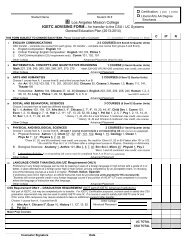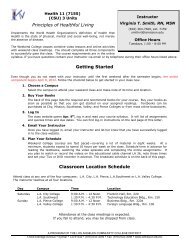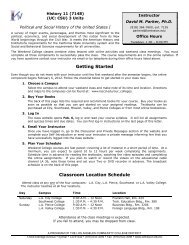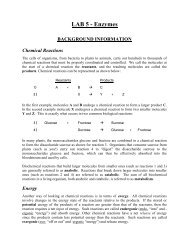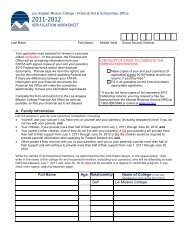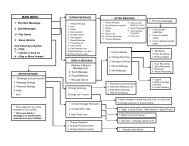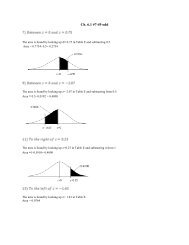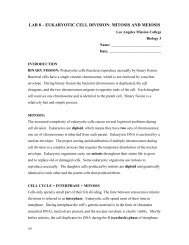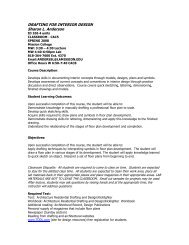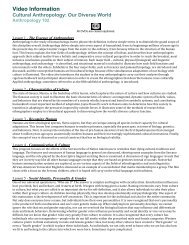Lab #3
Lab #3
Lab #3
Create successful ePaper yourself
Turn your PDF publications into a flip-book with our unique Google optimized e-Paper software.
STAGE and STAGE CLIP – The stage is the flat surface upon which you will place each slide you will<br />
examine. Notice that there is a moveable stage clip that can be used to secure the slide on the stage.<br />
Open and close the stage clip to see how it will snugly hold your slide in position.<br />
MECHANICAL STAGE KNOBS – To move the slide on the stage when it is secured in the stage clip, you<br />
will use the mechanical stage knobs on the underside of the stage to move the slide backward/forward<br />
and right/left. Adjust each knob to see how one knob controls backward/forward movement and the<br />
other knob controls right/left movement.<br />
COARSE FOCUS and FINE FOCUS KNOBS – In order for a specimen on a slide to be in focus, the distance<br />
between the specimen and the objective lens must be just right. The coarse focus knob, the larger of the<br />
two, will move the stage or objective lens (depending on the microscope) up and down quickly and quite<br />
visibly, altering the distance between them. It is very important that the coarse focus knob is only used<br />
with the low power or scanning objective lenses, otherwise the microscope or objective lenses could be<br />
damaged. Adjust the coarse focus knob to observe how quickly the focal distance changes. In contrast,<br />
the fine focus knob will move the stage or objective lens such a small amount that it is hardly noticeable<br />
to the naked eye. This is the knob you will use to get the perfect focal distance so the image will be crystal<br />
clear.<br />
CONDENSER LENS – Just underneath the stage is the condenser lens. This lens serves to capture and<br />
focus light from the lamp below onto the slide mounted on the stage. On many microscopes the<br />
condenser lens can be adjusted up or down with a knob beneath the stage. Examine the condenser on<br />
your microscope to see if it is adjustable. If so, be sure to adjust it as high (close to the stage) as possible<br />
since, for our purposes, this is where it should be set.<br />
DIAPHRAGM – The diaphragm is located within the condenser and is one of the most important pieces<br />
of the microscope, though it is often neglected by many students. The diaphragm allows you to adjust the<br />
amount of light passing through the slide by adjusting the diaphragm lever. Most of the time the<br />
diaphragm will be all the way open to allow the maximum passage of light. However it is important to<br />
adjust the diaphragm at times to reduce the amount of light passing through your specimen should the<br />
image be too bright or dim, and also to increase the contrast to allow you to see the specimen more<br />
easily against the background. For now, open the diaphragm all the way, and when using the microscope,<br />
do not forget to use the diaphragm.<br />
LAMP – The lamp emits light to illuminate the specimen so that you can actually see something.<br />
BASE and ARM – The base is the bottom of the microscope that sits on the table, and the arm is the<br />
vertical framework ascending from the base along the back of the microscope. When handling the<br />
microscope always hold the arm while supporting the base with your other hand.<br />
Proper Use of the Compound Light Microscope<br />
Exercise 1B – Steps to follow when using the microscope<br />
If you really want to be able to see a specimen on a slide, you must follow the steps on the next page<br />
every time you look at a new slide. The microscope will be your friend if you always use the following<br />
steps in their proper order. Before you begin, be sure your microscope is plugged in and the power is<br />
“on”. Before you start, clean all of the lenses with special lens paper which is soft enough to not scratch<br />
the lens. Do not use anything else for this purpose (paper towel, shirt, backpack…..) or you will scratch the<br />
lenses.



